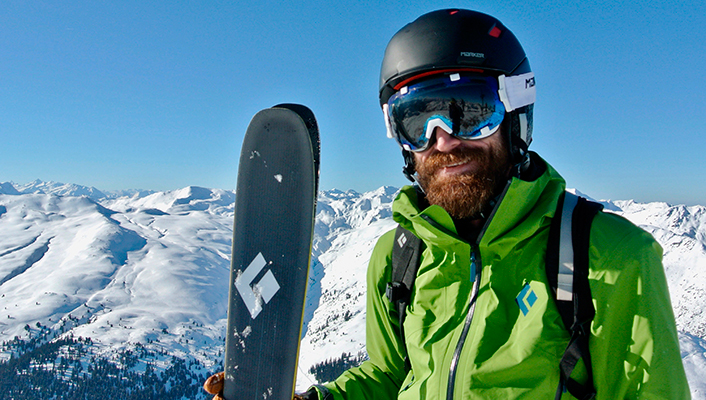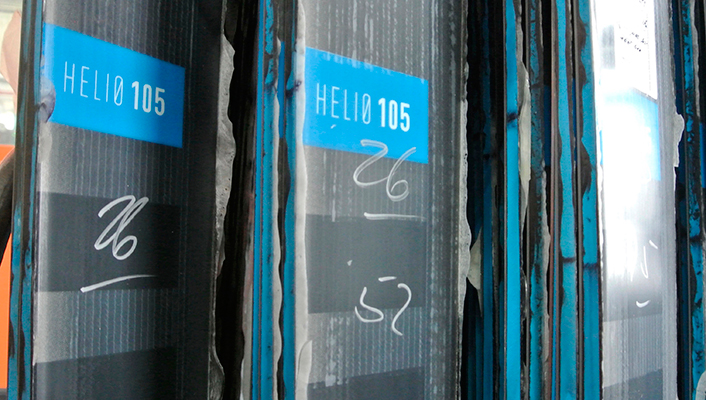A decade ago, for more than a year straight, Pete Gompert hounded Black Diamond Equipment for a job. At the time, the engineer in his mid 20s had a background developing airbags in the automotive industry and repairing airplane fatigue cracks for the Air Force. But while he’d tinkered with ski building in a friend’s garage, he lacked formal ski-design knowledge.
“Like every kid who’s an engineer and skis, I really wanted to work for a ski company,” says Gompert, who today lives an hour north of Salt Lake City, Utah near Snowbasin Resort. “They were really hesitant to hire me because I didn’t have any experience at all. I just kept bugging them.”
In January 2008, he finally talked Black Diamond into that job, and a decade later, the 38-year-old is a senior design engineer within a team of 20 or so product engineers and developers responsible for visioning and creating Black Diamond’s massive gear offering. And while Gompert has a hand in designing everything from carabiners and ice screws to ski poles and avalanche beacons, he’s primarily focused on skis and dialing in just the right ratio of performance to weight.
After touring the Blizzard Ski Factory in Mittersill, Austria, where all Black Diamond skis are made today, I sat down with Pete Gompert to learn about where ski design has been, where it’s going and which of the skis he’s designed over the last decade is his all-time favorite.

Pete Gompert, Black Diamond Equipment senior design engineer, looks ahead from the summit of Steinkogel. Austrian Tyrol. [Photo] Tyler Cohen
Pete Gompert: They had just moved ski production from the Atomic factory to China, and that was the point where BD had begun designing their own skis—like the blue Verdict and the brown Zealot. I was the only ski designer within literally two months of beginning there, so I just had to go for it. I totally screwed up my first ski design, and we had to recut the tool because it didn’t ski right. But it got better after we recut the tool. Ever since then, I’ve designed, I don’t know, a hundred skis when you factor in all the models and sizes. And then it’s BD, so I don’t just work on skis.
BCM: OK, so walk me through a day in the life of Pete the ski designer.
PG: I don’t know if I could—I’ve never had a normal day or week. I try to work from home a day or two a week, which is when I do most of my CAD work. Right now I’m on about eight different projects, and they’re all super different—skins over here and poles over there; I just finished up some ice tools, I’m working on some carabiner stuff, and I’m still working on the next Jetforce [airbag pack].
BCM: In your 10 years, how have Black Diamond’s skis changed and how have skis in general changed?
PG: I hit it right at the sweet spot. Until 2006, 2007 skis were pretty constant—skinny, normal shapes. Right then, stuff exploded. Skis got super wide and rockered, and everybody tried all sorts of stuff for a few years. It was a cool time—we had the Gigawatt and the Zealot and all these crazy things. Since then, people have started to figure it out—waist widths have started to come back down, sidecut [radii] are settling into the 20s, everybody’s gone to a bit of rocker with a sharp-nosed tip. The industry tried everything, and it’s fun to see everybody come to the same conclusion.

Gompert follows suit in the Austrian Tyrol. [Photo] Tyler Cohen
PG: It’s more about shape than anything, and it’s about getting all the pieces to work together. We spend time matching the sidecut shape to the flex pattern and do a bunch of math there, and I think that’s where most people blow it. Try and build skis from a cookbook, and you’re going to get in trouble, because you end up trying to piece together layups and things that aren’t meant to be there.
BCM: Talk to me about the choice to move production from Black Diamond’s own factory in China to the Blizzard Factory in Austria.
PG: We decided to build a factory in China three or four years ago because we weren’t getting the quality we wanted out of the supplier we had in China. And honestly, for what it was, it was a pretty amazing effort. Those guys built a factory from the ground up, and it was running and making great skis, but it came down to cost. We started looking around and went to basically every ski factory in the world, and Blizzard was the pretty obvious choice once we came here. One of the reasons is that they were willing to let us be us. It’s been great. The support we get is amazing. They run a really nice factory.

Hot off the presses: Black Diamond’s Helio 105 at the Blizzard Factory. Mittersill, Austria. [Photo] Tyler Cohen
PG: It starts with where you want to ski. BD is a weird place because everybody is a skier, and everybody there has an idea of the perfect ski, so just being in the building helps you figure out what the perfect ski is for whomever and what it will look like. There’s continual refinement, too. You’re not just going to reinvent the ski—I mean it would be rad if we did—but really it’s tweaking the sidecut or the rocker. That’s the beauty of experience; you get to collect all those ideas and merge them into something good.
BCM: How do you balance the need to develop and improve your products while also building the best ski possible in the moment?
PG: It’s hard, especially when you have a ski you really like. We have a lot of skis right now that we’ll redesign in a year or two, and I’m honestly struggling to figure out how to make them better. Not that they’re perfect—there are a few little things I would change—but I don’t necessarily want to go back to the drawing board. It’s a lot like car designers, I guess. You don’t necessarily reinvent the wheel every time, but you make the wheel a little lighter.

Pete Gompert pauses to reflect. [Photo] Tyler Cohen
PG: I think it’s in materials. You can always find a better base material, better edges, better cores. But I’m not sure that it’s going to come from our industry. We’re always going to weird trade shows and stuff. I’m going to the [shooting, hunting and outdoor] SHOT Show in two weeks because they might have stuff that applies to our climbing gear or skis somehow. I’m a car guy, so I’m always watching what the car industry is doing because they might come up with something that would be perfect for skis.
BCM: What’s your favorite ski that you have build?
PG: Depends on what it’s for. All around is the Boundary Pro 107. Just for skiing, on piste or off piste or whatever, I’m always happy if I’m on that ski. But I don’t tour on it like I’d tour on the Helio 105. I also have fond memories of the blue Zealot—but that’s because it went fast.










He was already skiing the new 2019 series. Would have been interesting to ask him what changes they made on the 2019 series (for example the Helio).